“Ye sight was very splendid & great”: Teddy Hall witnesses and celebrations of Coronations past
2 May 2023|James Howarth
- Library, Arts & Archives
As the Coronation of Charles III on 6 May 2023 approaches, I decided to investigate what connections I could find between Aularians and the Coronations of the last 350 years.
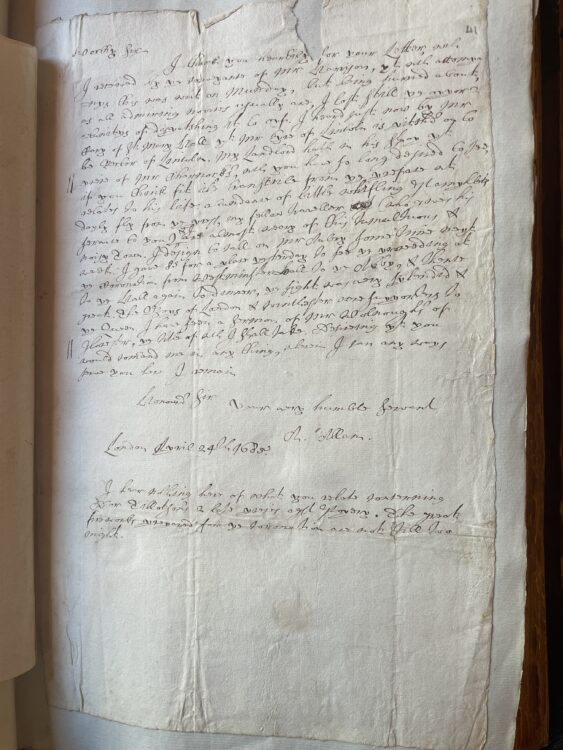
“Ye sight was very splendid & great”: Andrew Allam watches the Coronation of 1685
Andrew Allam matriculated at St Edmund Hall in 1671, where he had the misfortune to “fall under the tuition of a careless and crazed person,”. This was probably the Vice-Principal William Edwards (mat 1664), later described by Thomas Hearne as being of “of a very crazed and whimsical Temper, & void of Parts or learning”. Despite this, Allam successfully graduated BA and MA, was ordained and served as a tutor and Chaplain at the Hall before becoming Vice-Principal himself in 1682.
He was a great friend and correspondent of the Oxford historian Anthony Wood and shared his antiquarian interests. Much of the information we have about the Hall in this period comes from information Allam gave to Wood for his various literary projects and survive in his manuscript held at the Bodleian.
In April 1685, Allam visited London partly to undertake research on Wood’s behalf. Their correspondence survives, including a letter of 24 April where he briefly describes the Coronation procession of James II:
“I gave 8 shillinges for a place yesterday to see ye proceeding at ye Coronation from Westminster Hall to ye Abby, & thence to ye Hall again to dinner, ye sight was very splendid & great. The Bishops of London and Winchester were supporters to ye Queen… The great fireworks prepared for ye Coronation are not till too night.”
Quite how splendid and great the Coronation was, can be seen in The history of the coronation of the most high most mighty and most excellent monarch James II by the Heralds Francis Sandford and Gregory King. The book has a lengthy detailed description of events but the text is overshadowed by lavish double-paged illustrations of the Coronation.
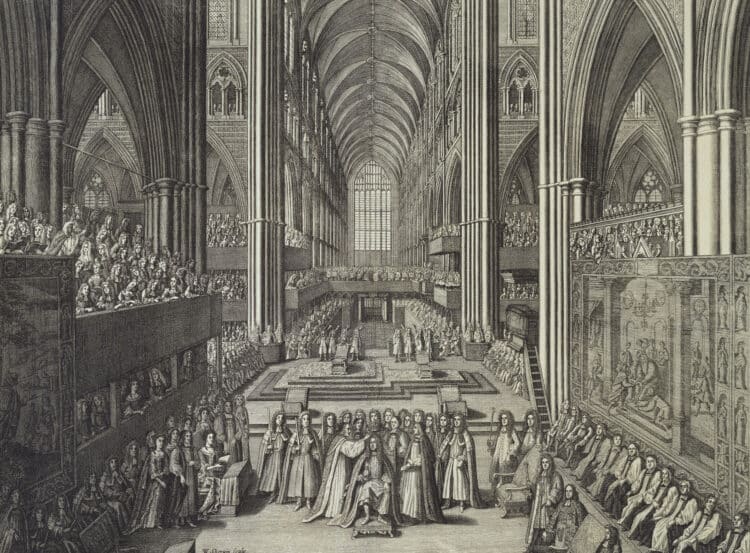
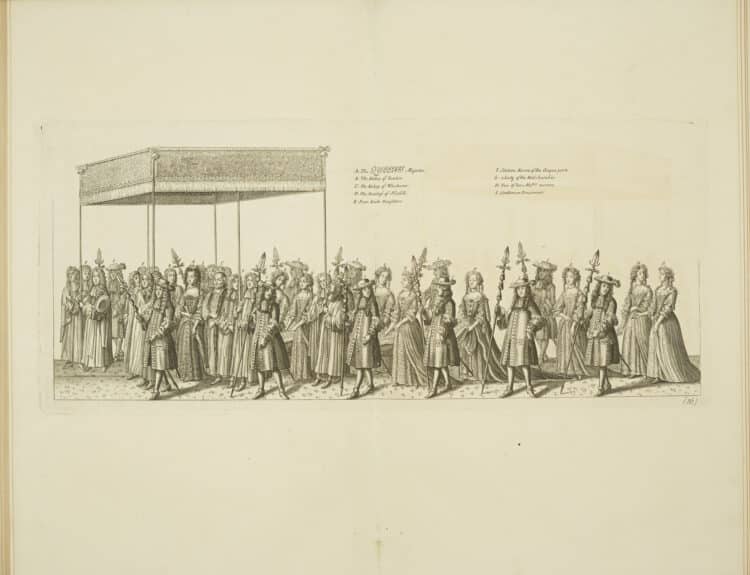
The procession alone is depicted across 40 pages, including one showing the new Queen, Mary of Modena, accompanied by the Bishops of London and Winchester as Allam reports (the interest here is perhaps which, if any, Anglican Bishops would attend the Queen who, like the new King, was Catholic).
The dinner at Westminster Hall is not only shown as a great panorama with onlookers in galleries above the tables and the King entering on horseback, but also a table plan shows all the dishes served. There 46 dishes of hot meat in the first course alone. Between courses the King’s Champion entered the Hall on a white horse and cast down a gauntlet three times challenging any who disputed James’ right to the throne. Although this was a ceremonial act it, it had added significance here as there had been attempts to exclude him from the crown.
Most spectacular of all, and worth Wood’s enquiry of them, are the fireworks that are shown in the book’s final image – although surely there must be some artistic license here, the swans at least seem unlikely.
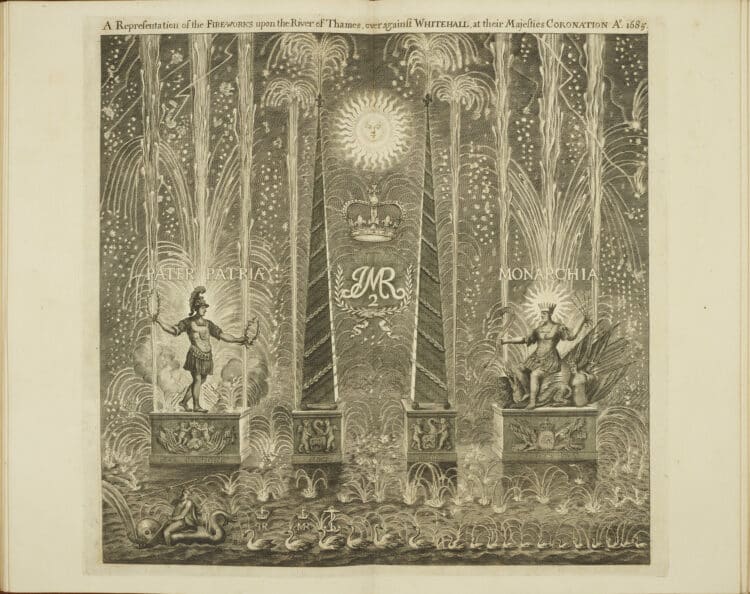
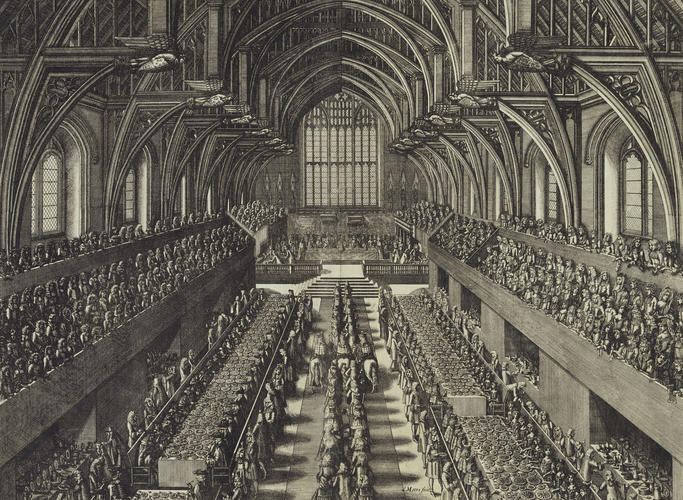
The book was so elaborate that it took two years to come to press, unfortunately it appeared in bookshops on the eve of the 1688 revolution that swept James from power. Despite having been given £300 by the King, the authors did not cover their own expenses. More sadly, at least for us, Teddy Hall does not hold a copy of the book, although one is for sale if anybody is feeling generous…
Wood himself describes the celebrations in Oxford. Following a service at the University Church attended by all the heads of houses and formal speeches at the Convocation House in the Bodleian, there were
“Great extraordinaries in eating and drinking in each College… At night bonefiers thro most parts of the city, in every College quadrangle, and before some of their gates. Healths drunk upon their knees to the king, queen, princess of Denmarke, princess of Orange.”
Sadly, Allam died of smallpox only five weeks after this. He was buried by the south wall of St Peter-in-the-East, which is now the College Library. His grave is under what is now the Librarians’ desk, perhaps adding a certain irony to Wood’s epitaph for his friend: “He understood the world of men well, authors better, and nothing but years and experience were wanting, to make him a compleat walking library.”
“For the Coronation is an act of the highest poetry”: Wilfred Hindle and the Coronation Souvenir Programme of 1937
A sumptuous programme was produced to mark the Coronation of the King’s Grandfather, George VI in 1937. Alongside many pictures of George VI and Royal Family, it includes a map of the coronation route and an order of service. John Masefield, the Poet Laureate, wrote an introductory poem and other contributors included the Archbishop of Canterbury Cosmo Gordon Lang and Sir Gerald Wollaston the Garter King of Arms who explained the significance of the various items used in the ceremony.
It was sold for one shilling on behalf of King George’s Jubilee Trust which had been set up for George V’s Silver Jubilee in 1935 to “provide more and better facilities for the recreation and guidance of the younger generation, to encourage the cultivation of abilities, craftsmanship and all those outdoor interests and activities which make for mental and physical fitness.”
The programme was edited by Wilfred “Tommy” Hindle (mat. 1921). Originally from Barrow-in-Furness, Hindle attended the Sorbonne after Teddy Hall and went on to become a journalist. The 1923 issue of the St Edmund Hall Magazine features an essay he wrote comparing study in Oxford and Paris (sample: “French students do not appear to do as much work as Oxford undergraduates, though they take their work more seriously.”)
In the 1930s, after working for The Yorkshire Post and The Times, he was the Literary Editor of the London Evening Standard, wrote editorials for the London Morning Post and was Editor of the Review of Reviews.
In 1938 he was recruited into the Secret Intelligence Service (SIS, ie MI6). Under the cover of working for the Foreign Office, he was posted to Budapest, Tehran – where was head of section – and Washington during World War II. He remained in the US after the war, and in 1947, after working for Time Magazine, he became Editor in Chief of the United Nation’s Editorial Controls Section. His A guide to writing for the U.N. is still published by the UN.
Shortly before his death in 1967, he hosted the first ever St Edmund Hall alumni event in the US at his flat in New York.
We present you with this Book, the most valuable thing that this world affords: Vivian Ridler and the 1953 Coronation Bible
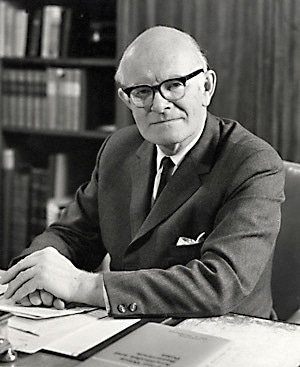
Vivian Ridler was the last great Master Printer to the University, serving from 1958 to 1978. Aularians may remember him as an enthusiastic member of the Senior Common Room (Professorial Fellow 1965-1978, then Emeritus Fellow until his death in 2009). He donated hundreds of books to the Library, not just during his time at Oxford University Press (OUP) but also from Perpetua Press, the private fine press he operated.
For the College, he printed the declaration sworn by Fellows, the College Grace and the bookplate that marks books bequeathed to the Hall by A.B. Emden. After his retirement, he and his wife Anne were regular participants in the Hall’s art weeks in the 1980s and 90s. A glass bowl he donated decorated with the College arms and Floreat Aula graces the SCR.
Amongst his many achievements at OUP was the design for the Bible presented to Queen Elizabeth II during the 1953 Coronation service and on which she swore the Coronation Oath. The large folio Bible, set by Ridler in a Perpetua typeface with a striking binding of musical staves and royal cyphers in red and cream by Lynton Lamb, is now in Lambeth Place Library (an identical copy is part of the Royal Collection) but a miniature reproduction was produced by OUP as a Coronation souvenir.
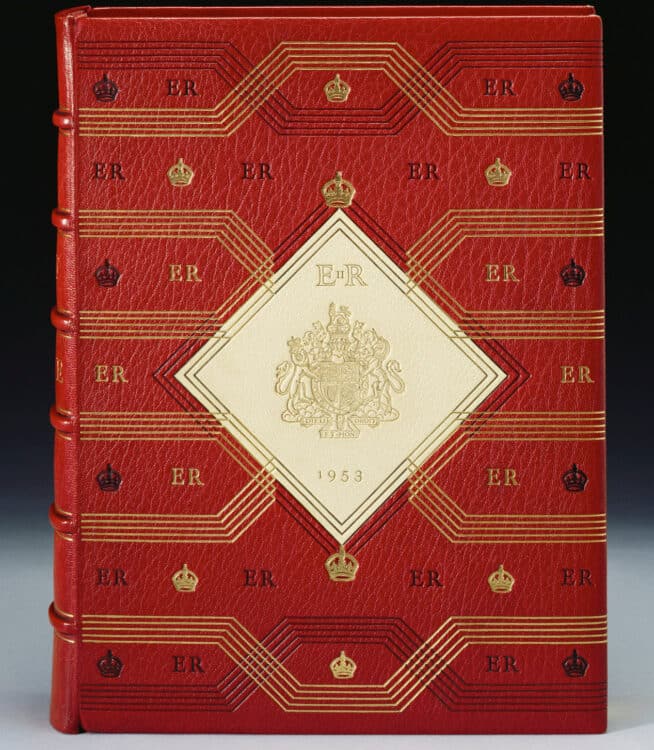
A Bible has been presented to the Monarch at every coronation since that of William III and Mary II in 1689. The 2023 Coronation Bible, as in 1953, was produced by Oxford University Press and the book binders Shepherds, Sangorski & Sutcliffe. It was presented to the Archbishop of Canterbury on 20 April 2023 ahead of the Coronation of Charles III on 6 May.
Celebrations in St Edmund Hall in 1953 are recorded in that year’s Hall Magazine. Not only in Queen’s Lane though, as the Magazine reports that more than half the student body decamped “by a surprising variety of modes of transport” to London to watch events in person. Many camped in the street, although some, like Andrew Allam in 1685 had prearranged places along the route.
Back in Oxford a Coronation Banquet was held in the Old Dining Hall, then the Manciple presented:
“a magnificent cake, bearing on its richly iced top a replica of the coronation coach drawn by nine horses”.
Students alas were not allowed to eat this, instead it was consumed by the Principal, the Fellows and the Fellows’ wives “before watching the ceremonies in the Abbey on television.”
Also, in celebration of the Coronation, the old decaying black and white sundial was replaced with a new colourful one painted blue and gold and decorated with symbols of the zodiac. It was inscribed: Auspice Elizabetha 11 horas non numero nisi serenas (“Under the auspices of Elizabeth II I count only cloudless hours”), this was composed by a student, David Weston (mat 1948) after an inscription on a sundial in Venice described by William Hazlitt. The sundial was repainted again in 2002 to mark the Queen’s Diamond Jubilee with the addition of “regnum inaugurante MCML/1, MMII decem lustra celebrante” (whose reign began in 1952 and celebrated 50 years in 2002) added to the inscription.
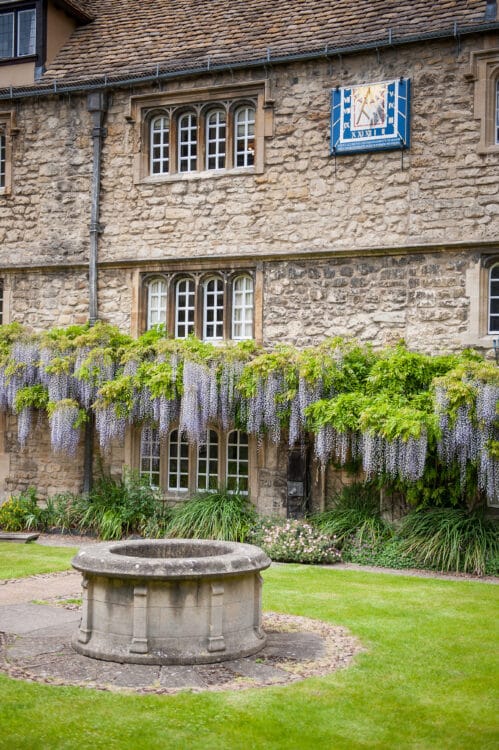
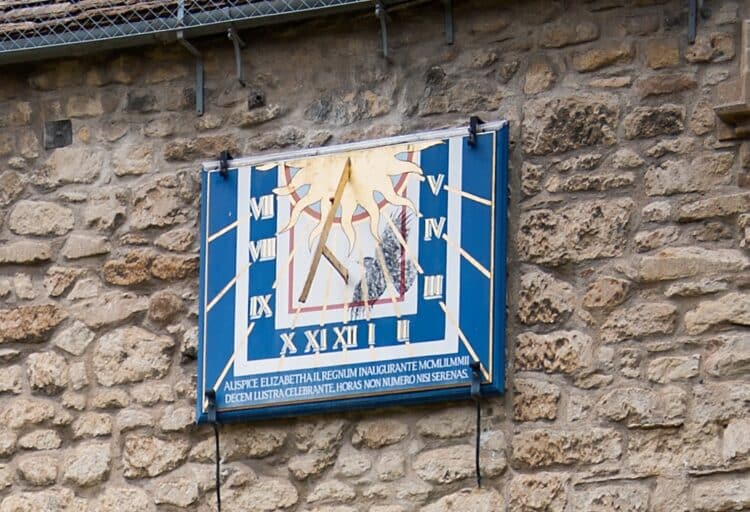
Kings and Aularian Things: Celebrating the Coronation in 2023
Hopefully the sundial will see cloudless skies on the Coronation weekend which will be marked by several events in Hall. On the morning of the 6 May a large TV will be in place in the Wolfson Hall for students to watch the ceremony, then the following day there will be a service in the Chapel and a celebratory Coronation-themed Formal Hall (alas perhaps not as elaborate as James II’s feast). The Old Library will be open for an exhibition ‘Kings and Aularian things: A celebratory exhibition for the Coronation‘ on Monday 1 May and Sunday and Monday 7-8 May.
Category: Library, Arts & Archives
Author

James
Howarth
James has been St Edmund Hall’s Librarian since May 2018. He is responsible for maintaining and developing the library’s collections – including the historic and special collections that are housed in the seventeenth-century Old Library and is keen to promote their use in research, study and outreach.